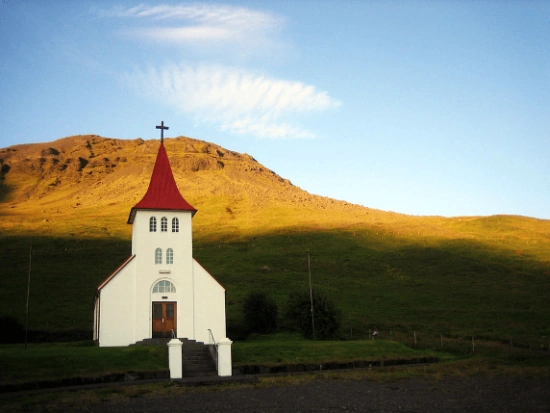
Koncept „církve“ ve spisech je složitý a krásně organický, spojený s učením o povaze Pána a výsledné přirozenosti lidstva.
Spisy říkají, že Pán je ve své podstatě - svou skutečnou podstatou - dokonalá, nekonečná láska, láska, která poháněla stvoření, která je konečným zdrojem reality a která neustále udržuje realitu. Tato láska je vyjádřena ve formě jako dokonalá, nekonečná moudrost, která dala formě stvoření a dává formě realitě.
Hluboké věci! Můžete o tom číst více jinde, ale záleží na tom, že celé stvoření, od nejmenších prvků po celý vesmír, odráží stejnou strukturu. Je přítomen v přírodě samotné, poháněn žárem (láskou) a světlem (moudrostí) slunce. Je přítomna v základních formách života, s rostlinami (které jsou zakořeněné; které se málo mění; které jsou necítitelné; které jsou poháněny světlem) představují prvky moudrosti a zvířat (teplo, pocit, mobilní, neustále se měnící, poháněné teplem) ) představující formy lásky. Je přítomen v téměř univerzálním rozdělení na mužské (moudrost) a ženské (láska) aspekty rostlin a zvířat.
Tato struktura je také v každém z nás. V běžném jazyce bychom jim mohli říkat naše srdce a naše mysli - to, co chceme a co si myslíme. Spisy o nich běžně mluví jako o dobrém (láska; to, co chceme v našich srdcích) a pravdě (moudrost; co víme v našich myslích) nebo jako vůle (srdce) a porozumění (mysl). Tyto prvky nás nejen definují, ale jsou také klíčem k našim duchovním osudům. Můžeme je použít k přijetí Pánovy lásky, vstoupit do dobra života a nakonec jít do nebe. Můžeme je také použít k odmítnutí Pánovy lásky a klusu do pekla.
A jsou tu další vrstvy. Spisy říkají, že všechny lidské společnosti jsou v lidské formě, s funkcemi analogickými lidskému tělu. To platí od malých skupin, jako jsou rodiny, velké společnosti, až po celé národy a v konečném důsledku i celá lidská rasa v tomto světě a celá nebe v příštím.
Mezi nejdůležitější lidské společnosti patří samozřejmě církve. Protože pojem „církev“ je však založen na lidské podobě, mohou mít církve, jak je uvedeno v spisech, mnoho podob. Na jednom konci stupnice je každý, kdo má skutečné představy o správném a špatném a žije podle nich, sám církví. Na druhém konci stupnice všichni ti, kdo věří v lásku k sousedovi - a jednají z této víry - společně tvoří jeden kostel.
Mezi těmito dvěma extrémy leží mnoho dalších odrůd, ale většina odkazů na „církev“ ve Spisech znamená komunitu těch, kteří mají Slovo, zná Pána a dodržují Jeho přikázání. Tito lidé mají přístup k nejlepší možné pravdě a nejhlubší možné pochopení o povaze Pána a toho, co od nás chce.
Takový kostel hraje zásadní roli: Pán skrze ni vytváří myšlenky o tom, že jsou dobré v myslích lidí a touze být dobří do vnitřních výklenků jejich srdcí, přičemž sahá daleko za samotnou církev a dotýká se každého na světě. Ve skutečnosti se ve spisech uvádí, že v podstatě existuje manželství mezi Pánem a církví, s církví v roli nevěsty a manželky, vytvářející skutečné myšlenky a dobré touhy, jak manželka vyrábí děti.
Aby tuto funkci ochránil, Pán se postaral o to, aby v celé historii (a hodně pravěku) vždy existoval kostel, který tuto roli plnil.
Prvním z nich byl nejstarší kostel, zastoupený Adamem; bylo to inspirováno láskou k Pánu. Druhým byla starověká církev, zastoupená Noemem; bylo to inspirováno láskou k bližnímu a poznání Pána. Třetí byla Izraelská církev, která neměla vnitřní lásku k dobrým, ale dochovaným myšlenkám Pána. Čtvrtá byla primitivní křesťanská církev, která měla nové, přímější porozumění založené na Pánově učení. Pátý, podle Písem, má být založen na hlubším porozumění nabízeném Písmy a jejich vysvětlením Bible.
Mohlo by se říci mnohem více, ale zdůrazníme jen jeden další bod:
My jako jednotlivci jsme, kdo jsme založeni na tom, co milujeme, ne na tom, co víme. Půjdeme do nebe nebo do pekla na základě toho, co milujeme, ne podle toho, co víme. Poznání, myšlení a hledání pravdy jsou důležité věci, ale jejich účelem je utvářet, vést a sloužit našim láskám; láska je nakonec důležitá. Spisy jasně a opakovaně jasně ukazují, že to samé platí pro církve: Konečně jsou založeny na lásce, ne na znalostech, na jejich odhodlání sloužit sousedovi, nikoli na jejich vnějších uctívání. A pokud církve sdílejí společný účel sloužit sousedovi, jsou v podstatě jedním z nich, přičemž doktrinální variace mají malý význam.
(Mga Sanggunian: Zjevená Apokalypsa 533; Nebeská tajemství 407, 768, 1799 [3-4], 2048, 2853 [2-3], 2910, 2982, 3310, 3773, 3963 [2], 4292, 4672, 4723, 5826 [2-3], 6637, 6648, 8152, 9256 [4-5], 9276 [2]; Manželská láska 116; Nebe a Peklo 57; Slovo 8; Nauka Nového Jeruzaléma o Písmu svatém 99, 104)






